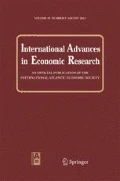Abstract
This paper studies the convergence of inflation rates over the period of 1983–93 for some countries within the European Monetary System. Three different price indices are considered for consumer goods, services, and industrial products. This study focuses on the difference between core and peripheral countries for measuring convergence speed. By using β- and σ-convergence tools, as previously identified in studies on output growth convergence, it was found that the convergence process did not evolve equally whether considered through price indices, time, or countries.
Similar content being viewed by others
References
Alderton, R. “Did the Underlying Behavior of Inflation Change in the 1980s? A Study of 17 Countries,”Weltwirtschaftliches Archiv, 133, 1, 1997, pp. 22–38.
Barro, R.; Sala-i-Martin, X. “Convergence,”Journal of Political Economy, 100, 2, 1992, pp. 223–51.
Berk, J.; Winder, C. “Price Movements in the Netherlands and Germany and the Guilder-DMark Peg,”De Economist, 142, 1994, pp. 63–74.
Bernard, A.; Durlauff, S. “Convergence in International Output,”Journal of Applied Econometrics, 10, 1995, pp. 97–108.
Bini-Smaghi, L.; Del Giovane, P. “Convergence of Inflation and Interest Rates Prior to EMU: An Empirical Analysis,”Journal of Policy Modeling, 18, 4, 1996, pp. 377–95.
Canzoneri, M.; Diba, B.; Endey, G. “Productivity and Inflation: Implications for the Maastrict Convergence Criteria and for Inflation Targets After EMU,” in Banco de España ed.,Economic Bulletin, Madrid, Banco de España, April, 1996.
De Grauwe, P. “Inflation Convergence During the Transition to EMU,”Economies et Societes, 26, 9–10, 1992, pp. 13–32.
Dornbusch, R. “Two-Track E. M. U. Now,” in Karl Otto Pohl et al. ed.,Britain and EMU, London: Centre for Economic Performance, LSE, 1992.
Giavazzi, F.; Pagano, M. “The Advantage of Tying One's Hands,”European Economic Review, 32, 5, 1988, pp. 1055–82.
Hall, S.; Robertson, D.; Wickens, M. “Measuring Convergence of the EC Economies,”The Manchester School LX, Supplement, 1992, pp. 99–111.
Lambertini, L.; Miller, M.; Sutherland, A. “Inflation Convergence with Realignments in a Two-Speed Europe,”The Economic Journal, 102, 411, 1992, pp. 333–41.
Marriot, F.; Pope, J. “Bias in the Estimation of Autocorrelations,”Biometrika, 41, 1954, pp. 390–402.
Symons, J.Econometric Issues in Convergence Regressions, mimeo, London: University College London, 1995.
Author information
Authors and Affiliations
Rights and permissions
About this article
Cite this article
Montuenga-Gómez, V.M. Did the EMS encourage inflation convergence?. International Advances in Economic Research 8, 119–127 (2002). https://doi.org/10.1007/BF02295342
Issue Date:
DOI: https://doi.org/10.1007/BF02295342




